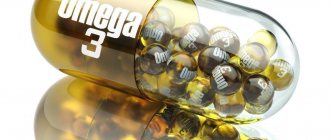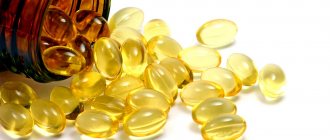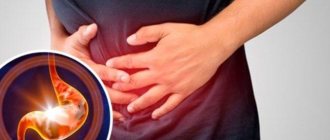Omega-3 is a vitamin compound of the group of unsaturated fatty acids. Used as a supplement to the general diet. Especially useful for the elderly, pregnant women and children. The product is an effective prevention of many diseases and helps normalize the body’s functioning.
Omega 3: what is it and what is it for?
Omega 3 belongs to the class of essential lipids, that is, the human body is not able to produce them on its own. It is unsaturated fatty acids that play an important role in general life. Since they participate in heat transfer, they protect cell membranes from negative influences, promote the production of sex hormones and the absorption of a number of fat-soluble vitamins.
Omega 3 begins its influence from the moment of conception, helping the proper formation of important body systems. Therefore, it is important to ensure the necessary intake of this compound from food or through dietary supplements.
How to choose natural fish oil
This is fat that is concentrated in the liver or muscles of fatty fish. Mainly in the form of triglycerides. Natural fish oil (TG) is the easiest way to provide your body with Omega-3 fatty acids.
Natural fish oil contains several important nutrients.
About 30% of fish oil is Omega-3 (EPA and DHA), while the remaining 70% consists of other fatty acids. In addition, natural fish oil contains vitamins A and D.
Cod liver is the most common source of natural fish oil. Typically, these Omega-3 complexes are sold in tinted glass or plastic bottles in liquid form. Bottled fish oil is also protected from oxidation by an inert gas.
Beneficial features
Omega 3 are essential triglycerides that help provide structural, energetic, bioregulatory and storage properties.
The benefits of lipids are as follows:
- Reduce the level of low density lipoproteins.
- Participate in the formation of sperm, cell membranes of neurons and the retina.
- Carries out oxygen transfer to tissues.
- Control the synthesis of their own hormones.
- Improves heart function.
- Helps maintain normal function of the musculoskeletal system.
- Suppress inflammatory processes and prevent the development of allergies.
- Increases the mental activity of the brain, improves attention and memory.
- Strengthens the body's defenses.
- Eliminates the production of stress hormones.
- Normalizes appetite.
- Improve endurance, restore muscle tone.
In addition, the triglyceride contains vitamin complexes that have a positive effect on the condition of the skin, vision and bone tissue.
Benefits of consuming fish oil
To get the maximum benefit, you should first find out all the features of Omega 3: at what age to take it, in what dosage, etc. By following all the rules, you can ensure a positive effect on the entire body:
- Reduce the risk of pathologies of the heart and blood vessels;
- Normalize high blood pressure in hypertensive patients;
- Increase the regenerative functions of the skin, slow down aging;
- Accelerate wound healing, incl. for stomach ulcers;
- Strengthen the immune and reproductive systems;
- Improve muscle tone;
- Reduce the risk of developing ophthalmic diseases, etc.
Fatty acid compounds are considered the strongest antioxidants, having the ability to lower “bad” cholesterol and eliminate the negative effects of free radicals. Omega-3 can reduce blood clotting and the risk of thrombosis, while increasing the flow of oxygen and valuable substances at the cellular level. Having the ability to increase the formation of the happiness hormone serotonin, they also slow down the production of stress hormones.
Indications
Due to its unique composition and high therapeutic properties, indications for the use of Omega 3 are:
- Overweight.
- Diabetes.
- Low body weight.
- Pathological processes of the musculoskeletal system.
- Dermatological diseases.
- Allergic reactions.
- Nervous overstrain.
- Diseases of the cardiovascular system.
- High blood cholesterol levels.
- Osteomyelitis.
Fatty acids are also widely used to prevent tumor formations of any origin.
Benefits and harms
For the body to function properly, it requires a minimum of 0.65 g of Omega 3 per day. If the fatty acid content decreases, lipid deficiency occurs.
Causes of deficiency of essential triglycerides:
- Poor nutrition, especially raw food diet and vegetarianism.
- Digestive system disorders.
- Starvation.
- Various diets.
A lack of Omega 3 in the body is indicated by:
- Strong and indomitable thirst.
- Dry skin.
- Deterioration of hair and nails.
- Diarrhea or constipation.
- Skin rashes.
- Development of symptoms of hypertension.
- Constant fatigue, tiredness, apathy.
- Poor memory, thinking and attention.
- Weak immune system.
- Psychoneurotic disorders.
Triglyceride deficiency provokes autoimmune, hormonal, neurological and cardiovascular pathologies.
Omega-3 capsules: features of production and administration
Each brand manufacturer provides recommendations on the use of Omega-3 capsules and instructions on how to take the drug. General advice includes the use of a food supplement as an auxiliary source of PUFAs for the full development of almost all organs, tissues and systems. The Omega-3 drug is usually available in the form of gelled (gelatin) capsules, the shell of which dissolves not in the stomach, but in the intestines, which helps to avoid “fish burps”. The capsules have no foreign taste, and the fish oil contained inside is protected from the negative effects of light and air. The capsule shape makes it easy to swallow with a minimum amount of liquid. Most often, Omega-3 capsules are packaged in glass or plastic tinted containers that protect the contents of the capsules from light. If the package does not indicate how to store Omega-3, then it is better to keep the jar in the refrigerator to slow down the oxidation of fats.
Dosage
Taking nutraceuticals with fish oil (or with Omega-3 acids already isolated from it) should be done strictly according to the manufacturer’s instructions after consulting with your doctor. The standard dosage of gelatin capsules for adults and adolescents over 12 years of age is 1 piece 2-3 times a day. The most effective time to take is during or after meals.
Course duration
Unless your doctor prescribes otherwise, the standard course of taking Omega-3 supplements is 4 weeks. If necessary, courses are repeated 3-4 times a year. But some experts recommend taking a preventative dose of fish oil on an ongoing basis. After all, fatty acids do not accumulate and are not synthesized in the body, so periodic intake is not as effective as regular intake. The main thing is not to exceed the dosage, taking into account the intake of fatty acids in the body through food.
Contraindications
The food supplement is contraindicated in the following cases:
- Allergic reactions to seafood.
- Children under 3 years old.
- Individual intolerance to substances included in the drug.
- Tuberculosis of any form.
- Liver and kidney diseases.
- Tendency to develop hemorrhagic syndrome.
- Excess vitamin D in the body.
- Various pathologies of the gastrointestinal tract in the acute or chronic period.
- Postoperative time.
How to take Omega 3 for children
The dietary supplement is an essential component for the healthy functioning of the immune, hormonal and neurological systems. In addition, it improves brain activity in a child, increases the body’s endurance and its susceptibility to various diseases.
Omega 3 deficiency in childhood contributes to the appearance of:
- Diathesis.
- Allergic reactions.
- Dry skin.
- Vision problems.
- Hyperactivity.
It is possible to normalize the body's systems after taking the drug. The following lipid complexes are available for children:
- Omega-3 from Oriflame.
- Smart Omega 3.
- Supradin Kids with choline and Omega 3.
Omega-3 polyunsaturated fatty acids
Omega-3 (ω-3) polyunsaturated fatty acids
(eng.
omega-3 fatty acids
) - fatty acids important for human physiology.
- “Polyunsaturated” means that a given fatty acid molecule has at least two double and/or triple carbon-carbon bonds.
- “Omega-3” or “ω-3” (or “n-3”) means that after the third (to the fourth) carbon atom, counting from the methyl end of the fatty acid chain, there is a double bond.
Which fatty acids belong to the omega-3 family?
Firstly, this is the so-called “essential” (or “essential”), that is, linolenic
(more correctly called
α-linolenic
)
acid
.
It is found in large quantities in some vegetable oils, and in small quantities in animal fats (see “Foods containing linolenic acid”). Secondly, these are two long-chain fatty acids that the human body can synthesize from the shorter linolenic acid, but, nevertheless, the main “suppliers” of which are sea fish from the northern seas and the meat of marine animals: eicosapentaenoic acid
and
docosahexaenoic acid
.
Thirdly, other, less important for human physiology (or less studied) omega-3 fatty polyunsaturated acids:
- hexadecatrienoic acid
- stearidonic (or octadecatetraenoic) acid
- eicosatrienoic acid
- eicosatetraenoic acid
- heneicosapentaenoic acid
- docosapentaenoic (or clupanodonic) acid
- tetracosapentaenoic acid
- tetracosahexaenoic (or nisic) and other acids
| The structure of the molecules of the most important omega-3 polyunsaturated fatty acids for humans (from top to bottom): α-linolenic, eicosapentaenoic and docosahexaenoic |
More details: list of omega-3 polyunsaturated acids.
Physiological needs and sources of omega-3 polyunsaturated acids
According to Methodological Recommendations MP 2.3.1.2432-08 “Norms of physiological needs for energy and nutrients for various groups of the population of the Russian Federation,” approved by Rospotrebnadzor on December 18, 2008, the physiological need for adults is 0.8-1.6 g/day omega- 3 fatty acids, 1-2% of the daily calorie intake. The optimal ratio of omega-6 to omega-3 fatty acids in the daily diet should be 5-10:1. The physiological need for omega-3 fatty acids for children is 1-2% of the daily caloric intake.
| The food chain through which long-chain omega-3 PUFAs synthesized by diatoms, cryptophytes and peridinium microalgae are transmitted to humans (Gladyshev M.I., 2012) |
Of all known organisms, only a few microalgae, such as diatoms, peridineans and cryptophytes, are capable of effectively synthesizing and accumulating large amounts of eicosapentaenoic and docosahexaenoic acids in their biomass.
Therefore, seas, lakes and rivers are the main deposits of long-chain omega-3 polyunsaturated fatty acids (PUFAs). Eicosapentaenoic and docosahexaenoic acids synthesized by microalgae are transferred along the food chain to aquatic invertebrates, from them to fish and then to humans and other terrestrial animals. Eating fish containing sufficient amounts of eicosapentaenoic and docosahexaenoic acids is for most people a necessary condition for the normal functioning of the circulatory and nervous systems. The greatest nutritional value in this regard is possessed by marine fish, which are found in the thickness of surface waters and their food chains are based on the production of diatoms and peridinium algae, as well as on planktonic copepods, capable of accumulating eicosapentaenoic and docosahexaenoic acids from microalgae in their biomass. Such fish are herring, sardine, capelin, which feed on zooplankton (copepods), and large salmon (salmon, pink salmon, sockeye salmon), which feed on smaller fish. Marine bottom fish, such as flounder, like almost all freshwater fish (tilapia, Nile perch, Victorian catfish), contain relatively few polyunsaturated fatty acids and its consumption in food cannot provide the recommended daily doses of eicosapentaenoic and docosahexaenoic acids (Gladyshev M.I. ., 2012). In fish, eicosapentaenoic and docosahexaenoic acids are not found in pure form, but as part of the phospholipids of cell membranes. This “packaging” prevents the degradation of long-chain omega-3 PUFAs during cooking. Therefore, in fried, boiled and baked fish (as well as in canned food), the content of eicosapentaenoic and docosahexaenoic acids does not decrease compared to raw fish. Thus, it is necessary to eat fish meat, and not “fish oil” rendered from it.
Biological effects of polyunsaturated omega-3 fatty acids
The biological effects exerted by omega-3 fatty polyunsaturated acids are realized at the cellular and organ levels. As a structural component of biological cell membranes, omega-3 PUFAs have a direct effect on:
- fluidity of the lipid biolayer, membrane permeability
- membrane-bound enzyme activity
- functioning of membrane receptors and antigen recognition
- electrophysiological properties of membranes
The amount and ratio of docosahexaenoic and arachidonic acids in the cell membrane determines its functions.
Thus, the viscosity and “fluidity” of a biological membrane depend on the predominance of omega-3 PUFAs. In connection with cell membrane proteins, PUFAs form special receptors that perceive and convert signals from the external environment, thus changing cellular metabolism in accordance with changing environmental conditions. Membrane enzymes, interacting with PUFA biolayers, acquire greater stability and the ability to carry out biochemical reactions. Such an environment provides proteins with “privileged” operating conditions. Thus, PUFAs have a regulatory effect on the electrophysiological properties of biomembranes and the functions of membrane proteins, which is of particular importance in tissues with high electrophysiological activity (brain tissue, retina).
Omega-3 PUFAs play a special role in the maturation and functioning of the central nervous system in children, stimulating neurogenesis, synaptogenesis, neuron migration, and participating in the process of myelination of nerve fibers. These PUFAs ensure the normal development of sensory, motor, behavioral functions due to concentration in synaptic membranes and modulation of neurotransmission (Zakharova I.N., Surkova E.N.).
The use of a fat emulsion containing omega-3 fatty acids in the postoperative period for experimental widespread purulent peritonitis helps restore the structure of the small intestine, liver and heart, reduces the severity of inflammation, and prevents the development of dystrophic and necrotic changes. Morphometric parameters of the adrenal glands of experimental animals receiving this drug in the postoperative period indicate its ability to prevent the development of pathological structural changes and hypofunctional state of the adrenal glands. The drug has an effective positive effect on protein-lipid ratios and the phospholipid spectrum of liver mitochondria in experimental widespread purulent peritonitis. The effect of the drug is associated with a decrease in the percentage of lysophosphatides in the spectrum of mitochondrial phospholipids, an increase in the level of polyglycerophosphatides and cardiolipin, which possibly helps maintain the osmotic stability of mitochondria, prevents the uncoupling of oxidative phosphorylation and hyperactivation of lipid peroxidation (Kosinets V.A.).
Content of main omega-3 polyunsaturated fatty acids in the cells of various human tissues (Gladyshev M.I., 2012), % of the sum of all fatty acids:
| linolenic | eicosapentaenoic | docosahexaenoic | |
| brain | <1 | <1 | 13 |
| retina | ~0 | <1 | 20 |
| liver | <1 | <1 | 3 |
| adipose tissue | <1 | <1 | <1 |
At the same time, a multicenter randomized placebo-controlled study performed by French scientists found that a multicomponent intervention (physical activity, cognitive training and dietary modification) and the intake of omega-3 polyunsaturated fatty acids, independently or in combination, did not have a significant effect on cognitive decline over 3 years in older adults with memory complaints.*
*Andrieu S, Guyonnet S, Coley N, et al. Effect of long-term omega 3 polyunsaturated fatty acid supplementation with or without multidomain intervention on cognitive function in elderly adults with memory complaints (MAPT): a randomized, placebo-controlled trial Lancet Neurol 2022. Doi: 10.1016/S1474-4422(17) 30040-6.
Hypothesis about the effect of omega-3 polyunsaturated fatty acids on reducing the incidence of coronary heart disease
Among peoples living on the shores of the seas and eating sea fish, seal and whale meat, the incidence of coronary heart disease (CHD) is significantly lower than the statistical average.
The effect of fish consumption on the clinical manifestations of coronary artery disease is presumably due to the consumption of long-chain polyunsaturated fatty acids of the omega-3 family, especially eicosapentaenoic and docosahexaenoic acids, which are found in significant quantities almost exclusively in the fat of marine fish and marine animals. However, this effect of fish consumption on the development of CHD may also depend on the reduction in the consumption of saturated (mainly animal) fats. The hypothesis that dietary omega-3 polyunsaturated fatty acids may be protective against CHD comes from studies of Greenlandic Eskimos whose diet was high in seafood (especially seal and whale meat) and who had a low incidence of CHD. . It was found that Eskimos have lower plasma levels of triglycerides and total cholesterol due to higher levels of atherogenic low-density lipoproteins and very low-density lipoproteins than the levels of these indicators in Danes. The concentration of antiatherogenic high-density lipoproteins was higher in Eskimo men than in Danish men. The amount of fish consumed, containing significant amounts of eicosapentaenoic and docosahexaenoic acids, had a beneficial effect on the concentration of lipids and lipoproteins in the blood plasma in populations of Japanese residents, East African tribes living on the coasts of lakes, and residents of the coasts of India and Russia. But no such effect was found in a study conducted in Tremso, Norway. Perhaps this is due in the latter case to the high consumption of saturated (animal) fats (Oganov R.G. Perova N.V.).
Potential mechanisms of the influence of long-chain omega-3 acids on reducing the risk of cardiovascular diseases (Shlyakhtko E.V. et al.):
- antifibrillatory activity and reduced risk of developing ventricular tachycardia
- antithrombogenic properties
- reduction in triglyceride levels (fasting and postprandial)
- anti-inflammatory activity
- reducing the growth of atherosclerotic plaque
- decreased expression of adhesion molecules on the surface of the endothelium and their content in circulating plasma
- decreased production of platelet-derived growth factor
- mild hypotensive effect
A report from the American Heart Association (AHA) dated March 3, 2017 states that heart failure patients taking dietary supplements containing omega-3 PUFA fish oil may live longer because it reduces mortality from heart disease by almost 10 percent. The association previously concluded that such supplements can prevent death from heart disease in people who have already had a heart attack, but cautioned that there is no convincing evidence that fish oil can prevent heart disease, primarily because the problem has not been studied. For most diseases, the evidence that omega-3 supplements are beneficial is insufficient. On the contrary, there is evidence that a diet rich in marine fish reduces the risk of death. That's why the AHA recommends that people eat at least one or two servings of oily fish every week.
FDA position
The US Food and Drug Administration (FDA) issued a special “Qualifying Statement” on September 8, 2004, in which it emphasized that there is scientific evidence confirming that omega-3 fatty acids, in particular, eicosapentaenoic acid and docosahexaenoic acid, found in fatty fish such as salmon, lake trout, tuna and herring, may be beneficial in reducing the risk of coronary heart disease.
The FDA recalls in this statement that it issued a similar statement in 2000 recommending that consumers not exceed a total of 3 g per day of EPA and DHA omega-3 fatty acids, including in dietary supplements, 2 g per day. The FDA's 4/25/2014 “final rule” regarding the labeling of foods and supplements containing α-linolenic acid, eicosapentaenoic acid, and docosahexaenoic acid prohibits food and dietary supplement labels from making claims that they are “high in » eicosapentaenoic and/or docosahexaenoic acid or their synonyms such as “rich”, “excellent source”, etc. in relation to these acids, and also, partially, to α-linolenic acid. This prohibition is based on the fact that, despite the various documents available, the FDA believes that the most authoritative US organizations, such as the Institute of Medicine of the National Academy of Medicine (IOM), have not officially determined their position regarding such levels and therefore they cannot be adopted by law .
Eicosapentaenoic and docosahexaenoic acids in fish
Content of eicosapentaenoic (EPA) and docosahexaenoic (DHA) acids in some species of fish from natural habitats (Gladyshev M.I., 2012), g/kg wet weight:
| View | EPK | DHA | EPA+DHA |
| Order Herring | |||
| Sardine (Sardinops sagax) | 6,6 | 19,0 | 25,6 |
| Herring (Clupea harengus) | 8,5 | 8,3 | 16,8 |
| European alosa (Alosa alosa) | 0,12 | 0,43 | 0,5 |
| Order Salmonidae | |||
| Salmon (Salmo salar) | 6,2 | 5,8 | 12,0 |
| Pink salmon (Oncorhynchus gorbuscha) | 1,7 | 3,3 | 5,0 |
| Brown trout (Salmo trutta) | 0,9 | 3,5 | 4,4 |
| Rainbow trout (Oncorhynchus mykiss) | 0,9 | 3,1 | 4,0 |
| Arctic char (Salvelinus alpinus) | 1,3 | 2,8 | 4,1 |
| American whitefish (Coregonus clupeaformis) | 0,7 | 2,4 | 3,1 |
| Grayling (Thymallus thymallus) | 0,9 | 2,0 | 2,9 |
| Siberian grayling (Thymallus arcticus) | 0,7 | 1,9 | 2,6 |
| Sockeye Salmon (Oncorhynchus nerka) | 0,8 | 1,9 | 2,6 |
| Order Smelt-like | |||
| Sea smelt (Hypomesus pretiosus) | 3,6 | 5,7 | 9,3 |
| Capelin (Mallotus villosus) | 3,6 | 4,6 | 8,2 |
| Order Scorpiformes | |||
| Canary Perch (Sebastes pinniger) | 3,5 | 5,4 | 7,9 |
| Red scorpionfish (Scorpaena scrofa) | 0,29 | 1,4 | 1,7 |
| Order Perciformes | |||
| Common horse mackerel (Trachurus trachurus) | 1,64 | 5,86 | 7,5 |
| Black Saberfish (Aphanopus carbo) | 0,8 | 2,9 | 3,7 |
| Laskir (Diplodus sargus) | 1,0 | 2,3 | 3,3 |
| Golden spar (Sparus aurata) | 0,9 | 2,0 | 2,9 |
| Sea bass (Dicentrarchus labrax) | 0,52 | 1,75 | 2,3 |
| Red mullet (Mullus barbatus) | 0,48 | 0,94 | 1,9 |
| Perch (Perca fluviatilis) | 0,3 | 0,9 | 1,2 |
| Ruff (Gymnocephalus cernuus) | 0,4 | 0,8 | 1,2 |
| Pike-perch (Sander lucioperca) | 0,2 | 0,8 | 1,1 |
| Tilapia zilli | 0,1 | 0,5 | 0,7 |
| Nile tilapia (Oreochromis niloticus) | 0,1 | 0,6 | 0,7 |
| Nile perch (Lates niloticus) | 0,1 | 0,5 | 0,6 |
| Dark croaker (Sciaena umbra) | 0,05 | 0,19 | 0,2 |
| Atlantic bonito (Sarda sarda) | 0,03 | 0,15 | 0,2 |
| Order Eels | |||
| Eel (Anguilla anguilla) | 1,6 | 2,2 | 3,7 |
| Order Codfish | |||
| Pollock (Theragra chalcogramma) | 1,0 | 2,4 | 3,4 |
| Hake (Merluccius productus) | 0,9 | 1,5 | 2,4 |
| Cod (Gadus morhua) | 0,6 | 1,5 | 2,1 |
| Burbot (Lota lota) | 0,5 | 0,9 | 1,3 |
| Merlan (Gadus merlangus) | 0,08 | 0,48 | 0,6 |
| Order Flounders | |||
| Flounder (Lepidopsetta bilineata) | 1,8 | 1,1 | 2,9 |
| Order Cypriniformes | |||
| Ide (Leuciscus idus) | 0,5 | 1,1 | 1,6 |
| Silver crucian carp (Carassius gibelio) | 0,6 | 1,0 | 1,6 |
| Roach (Rutilus rutilus) | 0,4 | 1,0 | 1,4 |
| Guster (Blicca bjoerkna) | 0,4 | 0,8 | 1,2 |
| Bream (Abramis brama) | 0,4 | 0,6 | 1,0 |
| Tench (Tinca tinca) | 0,3 | 0,5 | 0,8 |
| Golden crucian carp (Carassius carassius) | 0,2 | 0,6 | 0,8 |
| Order Pike-like | |||
| Pike (Esox lucius) | 0,3 | 1,0 | 1,3 |
| Order Catfish | |||
| Victorian catfish (Synodontis victoriae) | 0,2 | 0,7 | 0,9 |
| Sudanese catfish (Bagrus docmas) | 0,1 | 0,7 | 0,8 |
| Longwhiskered catfish (Clarias gariepinus) | 0,2 | 0,5 | 0,7 |
| Order Mullet-shaped | |||
| Mullet (Mugil cephalus) | 0,46 | 0,08 | 0,5 |
| Order Dipulmonidae | |||
| Great protopterus (Protopterus aethiopicus) | 0,1 | 0,3 | 0,4 |
| Order Sarganiformes | |||
| Garfish (Belone belone) | 0,01 | 0,15 | 0,2 |
Omega-3 acids in medicines and dietary supplements
Omega-3 acids (eicosapentaenoic and docosahexaenoic) or their triglycerides are included in a number of medicinal products registered in Russia: Eikonol, Omacor, Vitrum cardio Omega-3*.
According to ATX, these drugs belong to the section “C10 Lipid-lowering drugs” and have the code “C10AX06 Omega-3 triglycerides, including other esters and acids”. They are used as adjuncts to reduce the concentration of cholesterol in the blood in the so-called “bad” lipoproteins: low-density lipoproteins (LDL) and very low-density lipoproteins (VLDL). Omega-3 polyunsaturated acids, in combination with other fatty acids, are part of the active ingredient "Fat emulsions for parenteral nutrition "
)", ATC code "B05BA02 Fat emulsions". In particular, the parenteral nutrition preparation Omegaven (calculated per 100 g of active ingredient, highly purified fish oil) contains:
- docosahexaenoic acid - 14.4–30.9 g
- eicosapentaenoic acid - 12.5–28.2 g
- docosapentaenoic acid - 1.5–4.5 g
- octadecatetraenoic acid - 0.5–6.54 g
- linolenic acid - less than 2 g
Two combinations of lipid-lowering drugs with omega-3 acids have been assigned new ATC codes and are planned to be included in the group “C10 Lipid-lowering drugs” from 2022:
- C10BA07 Rosuvastatin and omega-3 fatty acids
- C10BA08 Atorvastatin and omega-3 fatty acids
Examples of biologically active additives containing omega-3 fatty acids are: dietary supplement "Fish oil" (Biafishenol), dietary supplement "Fish oil" (BioContour), dietary supplement Möller's Dobbel Omega-3.
Note. For drugs marked with an asterisk, registration in Russia has ended and there is no information about its renewal. In pharmacies, a number of them can be sold as dietary supplements.
On the website GastroScan.ru in the Literature section there is a subsection “Eating disorders and metabolic disorders, obesity, metabolic syndrome”, containing articles for healthcare professionals that address these issues.
Omega-3 polyunsaturated fatty acids have contraindications, side effects and application features; if used systematically for health purposes or as part of medications or dietary supplements, consultation with a specialist is necessary. Back to section
Is it possible to drink Omega 3 during pregnancy?
Taking essential fatty acids is beneficial from the period of conception until childbirth. The nutritional supplement promotes the proper formation of organs and systems of the fetus during intrauterine development, preventing various pathologies.
In addition to the benefits for the baby, Omega 3 is necessary for women. The medicine improves cognitive activity, calms the nervous system and has a positive effect on heart function, immunity and hormonal levels.
The use of lipids is completely justified during pregnancy. However, taking it is permissible after a doctor’s prescription, since the drug has contraindications.






